Discover how AI-powered voice bots are revolutionizing customer interactions across industries! In this comprehensive guide, we’ll explore the fascinating world of voice bot technology, from its evolution to its promising future. You’ll learn about the different types of voice bots, their wide-ranging applications, and the benefits they bring to businesses. We’ll also delve into the challenges faced by this technology and provide best practices for implementation. Whether you’re a business owner or a tech enthusiast, this article will equip you with valuable insights into the transformative potential of voice bots in our digital age.
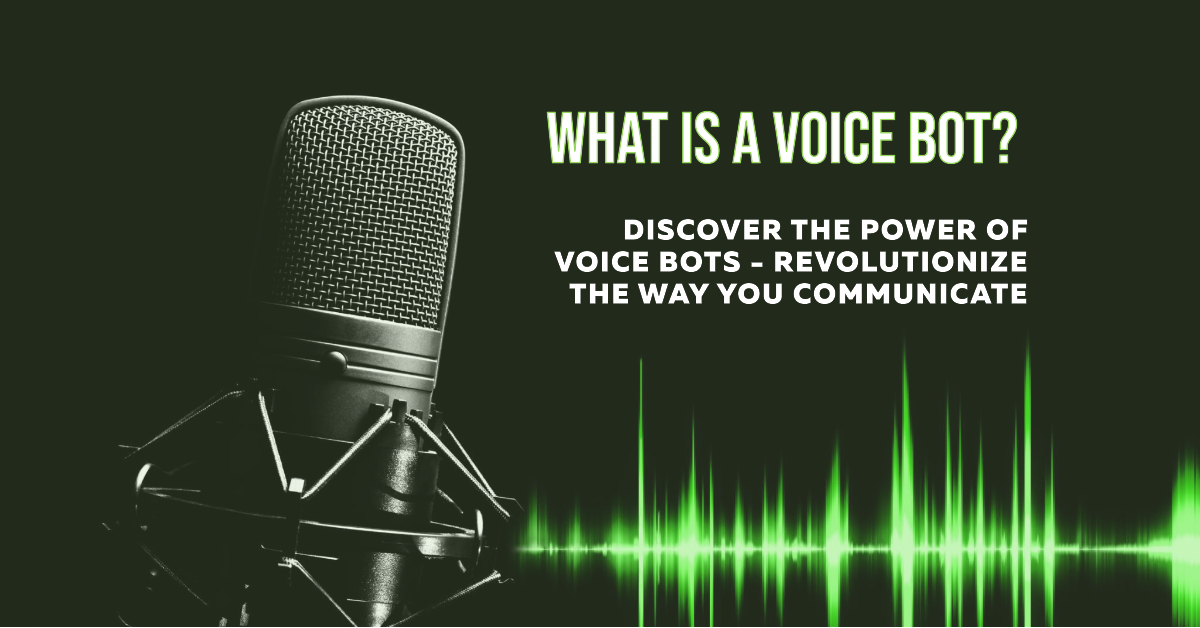
What is a Voice Bot?
A voice bot, also known as a voice assistant or conversational AI, is a sophisticated software application that uses artificial intelligence to interpret human speech, understand user intent, and provide relevant responses or actions through synthesized speech. Unlike traditional Interactive Voice Response (IVR) systems, voice bots can engage in more natural, dynamic conversations, adapting to user inputs and context.
Key Components of Voice Bots
- Automatic Speech Recognition (ASR): This component converts spoken words into text, allowing the system to understand what the user is saying. ASR technology has advanced significantly in recent years, now capable of recognizing various accents, dialects, and even filtering out background noise.
- Natural Language Understanding (NLU): Once the speech is converted to text, NLU algorithms analyze the text to interpret the user’s intent and extract relevant information. This involves parsing the text, identifying key phrases, and understanding context and nuances in language.
- Text-to-Speech (TTS): After processing the user’s input and generating a response, TTS technology converts the text response back into spoken words. Modern TTS systems can produce incredibly natural-sounding speech, often indistinguishable from human voices.
Distinction from Chatbots and Other AI Assistants
While voice bots share similarities with chatbots and other AI assistants, there are key distinctions:
- Input/Output Method: Voice bots primarily use speech for both input and output, whereas chatbots typically rely on text-based interactions.
- Complexity of Processing: Voice bots require additional layers of processing (ASR and TTS) compared to text-based chatbots.
- Use Cases: Voice bots are particularly useful in hands-free scenarios, such as while driving or in smart home applications, where chatbots might be less convenient.
- Natural Interaction: Voice interactions can feel more natural and conversational compared to typed interactions, potentially leading to higher user engagement and satisfaction.
The Evolution of Voice Bot Technology
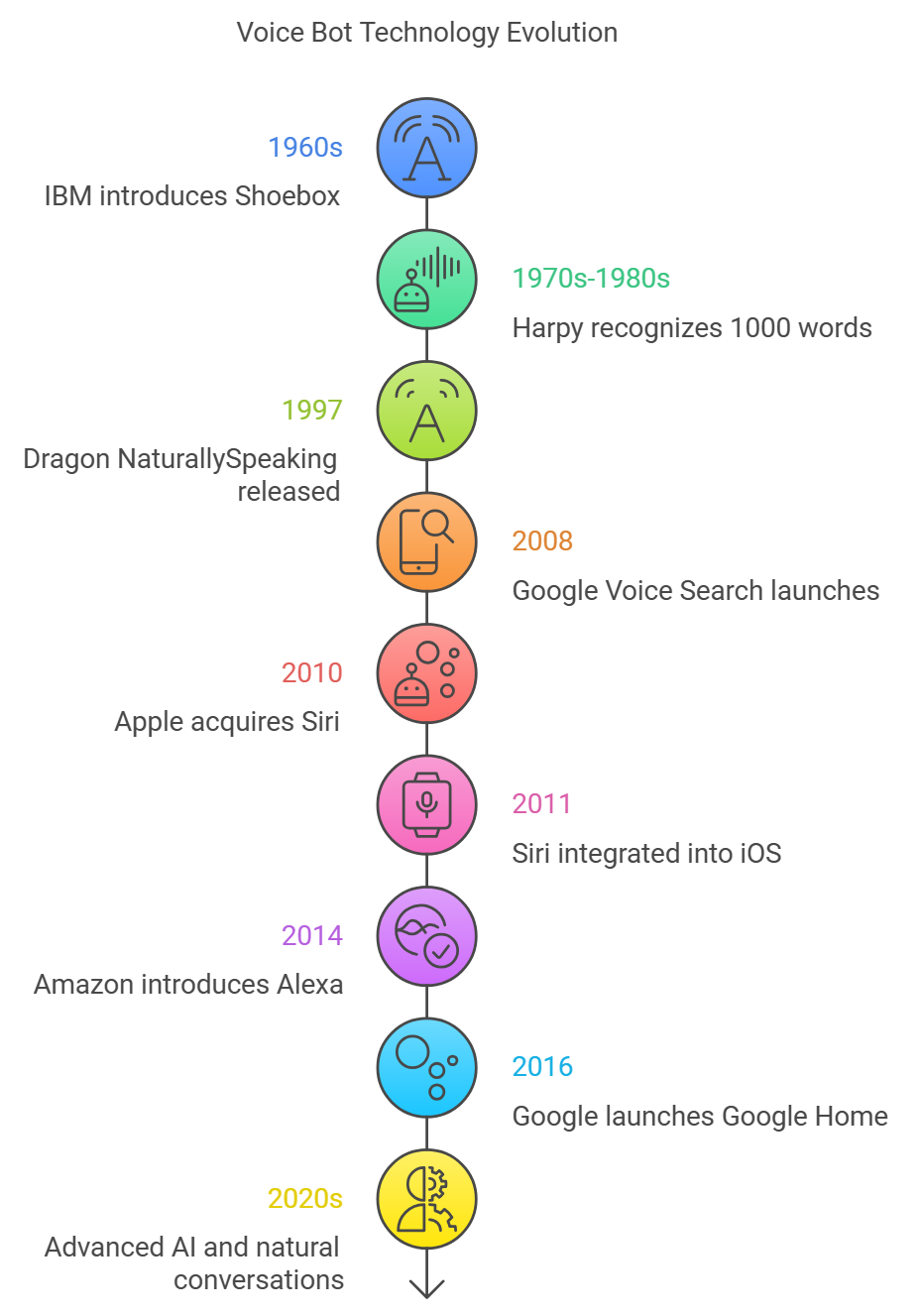
How Do Voice Bots Work?
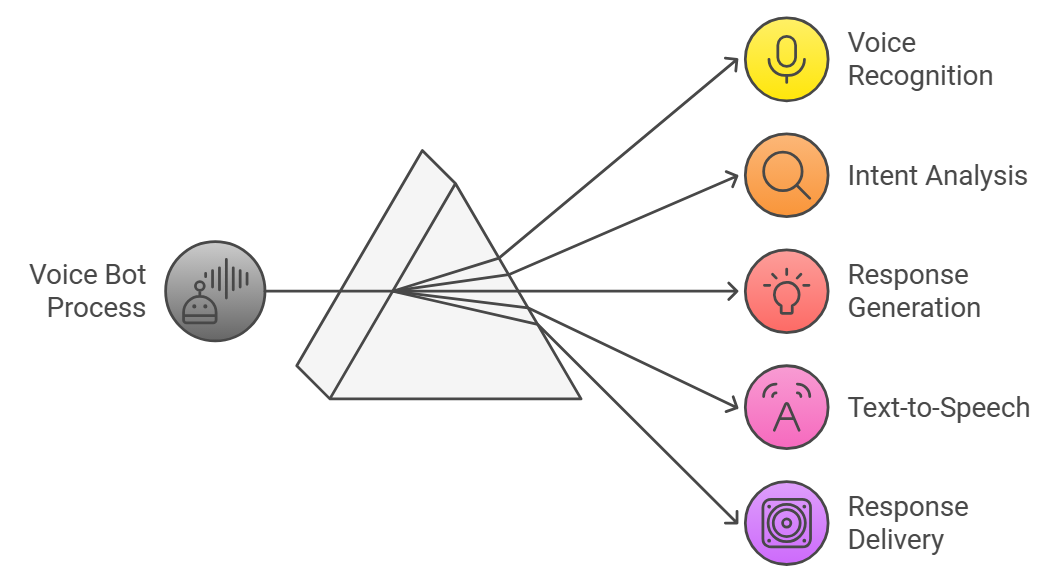
Voice bots operate through a sophisticated process that combines several AI technologies to understand, interpret, and respond to human speech. The process begins with voice recognition, where the user’s speech is converted into text using Automatic Speech Recognition (ASR) technology.
Next, Natural Language Understanding (NLU) analyzes the text to determine the user’s intent. Based on this analysis, the voice bot generates a response, either by retrieving pre-programmed answers or using AI algorithms for more complex interactions.
Finally, the response is converted back into speech using Text-to-Speech (TTS) technology and delivered to the user. This seamless integration of technologies enables voice bots to engage in natural, context-aware conversations with users.
Core Technologies Powering Voice Bots
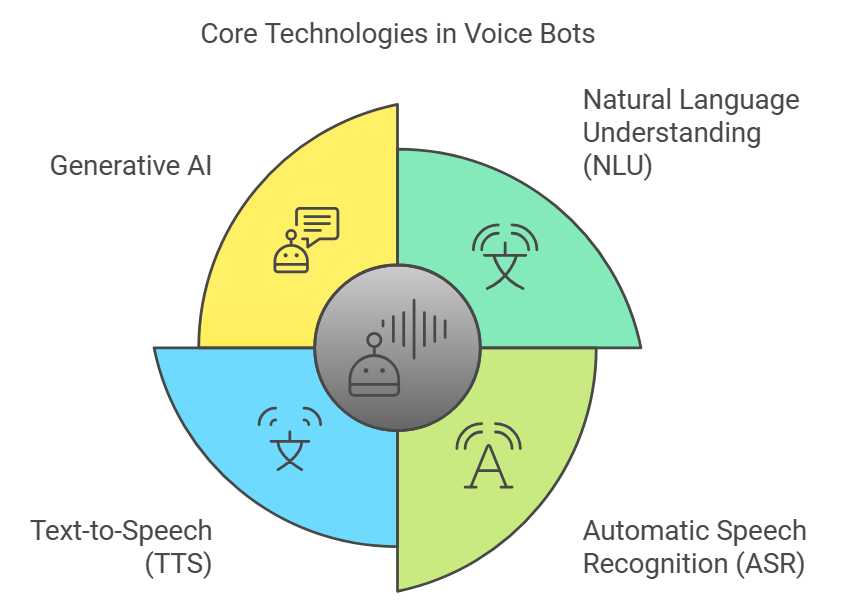
The foundation of voice bot technology lies in four core components: Natural Language Understanding (NLU), Automatic Speech Recognition (ASR), Text-to-Speech (TTS), and Generative AI. NLU enables voice bots to comprehend the meaning and context of user inputs, going beyond simple keyword recognition.
ASR has evolved to handle diverse accents and languages, continuously improving its accuracy through deep learning models. TTS technology has advanced significantly, now capable of producing near-human quality speech with appropriate intonation and emotion. The integration of Generative AI models, such as GPT, has further enhanced voice bots’ ability to engage in dynamic, context-aware conversations.
At MissNoCalls, we leverage these cutting-edge technologies to create highly sophisticated voice bots that can handle complex customer interactions with ease. Our AI-powered voice solutions are designed to provide seamless, natural conversations that enhance customer experiences across various industries.
Types of Voice Bots
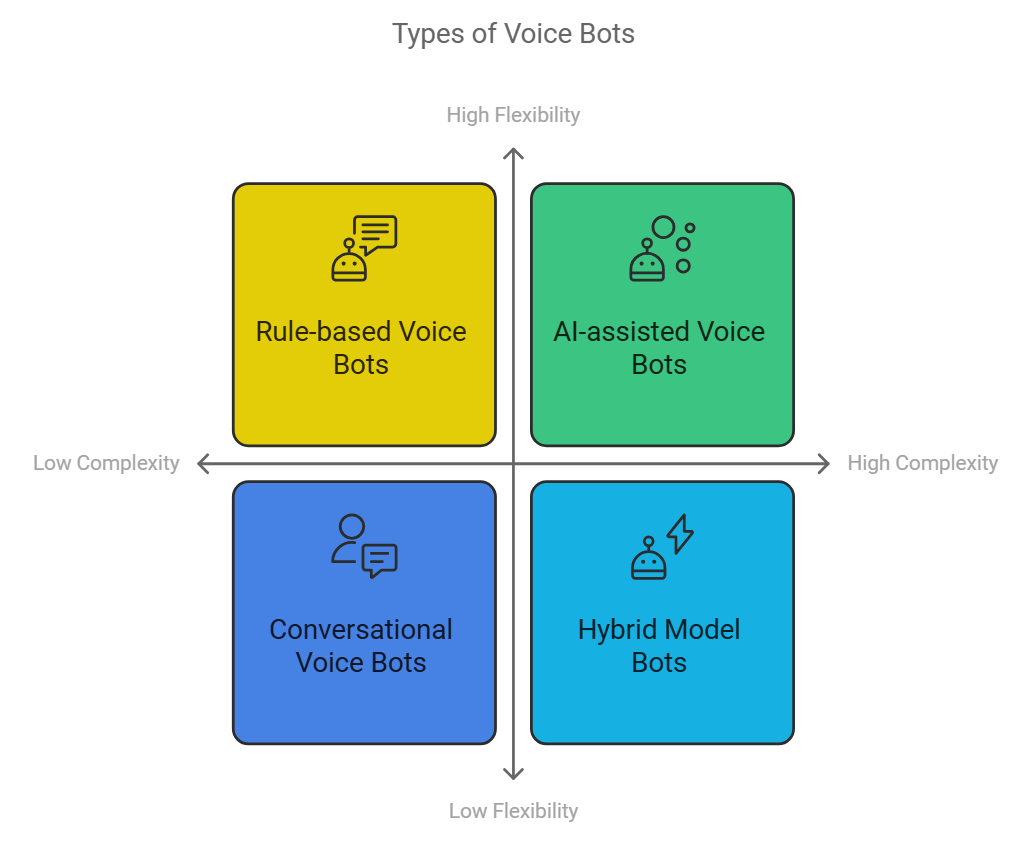
As voice bot technology has evolved, different types have emerged to cater to various business needs and use cases. At MissNoCalls, we offer a range of voice bot solutions to meet the diverse requirements of our clients. Let’s explore the main types of voice bots:
1. Rule-based Voice Bots
- These bots follow pre-defined rules and decision trees to handle user interactions.
- Best suited for simple, straightforward tasks with limited variability.
- Pros: Easy to set up, predictable responses.
- Cons: Limited flexibility, can struggle with complex or unexpected queries.
2. AI-assisted Voice Bots
- Utilize artificial intelligence to understand and respond to user inputs more dynamically.
- Can handle a wider range of queries and adapt to different contexts.
- Pros: More flexible than rule-based bots, can understand natural language better.
- Cons: Require more data and training to function effectively.
3. Conversational Voice Bots
- Powered by advanced natural language processing and machine learning algorithms.
- Can engage in more natural, human-like conversations.
- Pros: Highly adaptable, can handle complex interactions, and provide personalized experiences.
- Cons: More complex to develop and maintain, require significant training data.
4. Hybrid Model Bots
- Combine rule-based systems with AI capabilities for optimal performance.
- Use rules for common, straightforward tasks and AI for more complex interactions.
- Pros: Balance of reliability and flexibility, can be customized for specific business needs.
- Cons: Require careful design to seamlessly integrate both rule-based and AI components.
Our advanced AI voicemail system is an excellent example of a hybrid model bot, combining rule-based efficiency with AI flexibility.
Applications of Voice Bots
Voice Bot Adoption Rates by Industry
Voice bots have found applications across various industries, revolutionizing how businesses interact with their customers and streamline operations. Here are some key applications:
1. Customer Service and Support
- 24/7 customer support for handling inquiries, troubleshooting, and issue resolution.
- Example: MissNoCalls’ AI-powered customer service bots can handle a wide range of customer queries, reducing wait times and improving satisfaction.
2. Healthcare
- Patient scheduling and appointment reminders.
- Medication reminders and adherence tracking.
- Symptom checking and preliminary health assessments.
- Example: Our healthcare-specific voice bots can manage patient schedules and provide medication reminders, improving patient care and reducing administrative burdens.
3. Retail and E-commerce
- Product recommendations and information.
- Order tracking and status updates.
- Voice-based shopping assistance.
4. Smart Home Automation
- Control of smart home devices (lights, thermostats, security systems).
- Voice-activated routines and schedules.
5. Banking and Finance
- Account balance inquiries and transaction history.
- Bill payments and fund transfers.
- Fraud alerts and security notifications.
6. Travel and Hospitality
- Flight and hotel bookings.
- Travel information and itinerary management.
- Hotel service requests and concierge services.
Benefits of Voice Bots
Implementing voice bots can bring numerous advantages to businesses across various sectors:
😊 Improved Customer Experience
- Instant responses to customer queries, reducing wait times.
- Consistent service quality across all interactions.
- Example: MissNoCalls’ voice bots ensure that no call goes unanswered, significantly enhancing customer satisfaction.
🕰️ 24/7 Availability
- Round-the-clock service without the need for human staff.
- Ability to handle inquiries during peak times or off-hours.
💰 Cost Reduction and Operational Efficiency
- Automation of routine tasks, freeing up human agents for more complex issues.
- Reduced need for large customer service teams.
- Example: Our clients have reported up to 30% reduction in operational costs after implementing our AI voice solutions.
🌍 Scalability and Multilingual Support
- Easily scalable to handle increasing call volumes without additional staffing.
- Ability to provide support in multiple languages, expanding global reach.
♿ Accessibility for Users with Disabilities
- Voice interactions can be easier for users with visual impairments or mobility issues.
- Enhanced accessibility can lead to improved customer inclusion and satisfaction.
🎯 Personalized Interactions
- AI-powered voice bots can learn from past interactions to provide more tailored experiences.
- Ability to access customer history and preferences for contextual responses.
Implementing Voice Bots: Best Practices
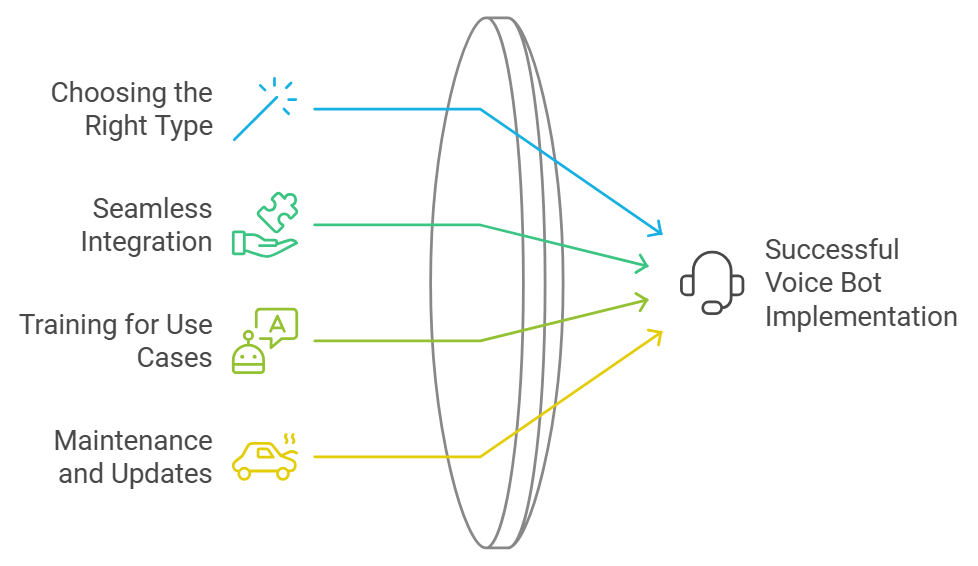
To maximize the benefits of voice bot technology, consider these best practices for implementation:
1. Choosing the Right Type of Voice Bot for Your Needs
- Assess your specific use case, target audience, and desired outcomes.
- Consider factors like complexity of interactions, scalability requirements, and integration needs.
- MissNoCalls offers consultations to help businesses determine the most suitable voice bot solution for their unique requirements.
2. Ensuring Seamless Integration with Existing Systems
- Plan for integration with your current CRM, knowledge base, and other relevant systems.
- Ensure data can flow smoothly between the voice bot and your existing infrastructure.
- Our voice bot solutions are designed for easy integration with over 6,000 apps, streamlining the implementation process.
3. Training Voice Bots for Specific Use Cases
- Provide comprehensive training data that covers a wide range of potential interactions.
- Regularly update the bot’s knowledge base with new information and scenarios.
- Continuously monitor and refine the bot’s performance based on user interactions.
4. Maintaining and Updating Voice Bot Systems
- Establish a regular maintenance schedule to ensure optimal performance.
- Keep the underlying AI models and NLP engines up-to-date.
- Regularly gather and analyze user feedback to identify areas for improvement.
- MissNoCalls provides ongoing support and updates to ensure your voice bot system remains cutting-edge and effective.
At MissNoCalls, we offer flexible pricing models to suit different business needs and scales, from DIY options to fully customized enterprise solutions.
Conclusion
Voice bot technology has come a long way since its inception and is now poised to revolutionize how businesses interact with their customers and streamline their operations. From improving customer experiences and operational efficiency to enabling 24/7 support and personalized interactions, voice bots offer a wide array of benefits across various industries.
While challenges such as handling diverse accents and ensuring data privacy exist, ongoing advancements in AI and NLP are continuously addressing these issues. The future of voice bot technology looks bright, with developments in emotional AI, multimodal interactions, and industry-specific solutions on the horizon.
At MissNoCalls, we’re committed to staying at the forefront of these innovations, providing cutting-edge voice bot solutions that help businesses transform their communication strategies and never miss an opportunity to engage with their customers.
To learn more about how voice bots can transform your business communication, contact us for a personalized consultation.
FAQs
1. How do voice bots differ from chatbots?
Voice bots interact through spoken language, using speech recognition and text-to-speech technologies. Chatbots, on the other hand, typically interact through text-based conversations. Voice bots can offer a more natural and hands-free interaction, while chatbots are often better suited for situations where text-based communication is preferred.
2. Are voice bots secure for handling sensitive information?
Yes, when implemented correctly, voice bots can be secure for handling sensitive information. At MissNoCalls, we prioritize data security by using encryption, secure protocols, and complying with relevant data protection regulations. However, it’s crucial to work with reputable providers and follow best practices in data security when implementing voice bot systems.
3. Can voice bots understand different languages and accents?
Modern voice bots are increasingly capable of understanding multiple languages and a wide range of accents. This is achieved through extensive training on diverse speech data. However, the accuracy may vary depending on the specific system and the diversity of its training data. MissNoCalls offers multilingual voice bot solutions that can be customized to understand specific regional accents and dialects.
4. How much does it cost to implement a voice bot system?
The cost of implementing a voice bot system can vary widely depending on factors such as the complexity of the system, the level of customization required, and the scale of deployment. Some solutions offer pay-as-you-go models, while others might require upfront investment in custom development. At MissNoCalls, we offer flexible pricing models to suit different business needs and scales, from DIY options to fully customized enterprise solutions.
5. Can voice bots completely replace human customer service agents?
While voice bots can handle a large portion of customer interactions, especially routine queries and tasks, they are not designed to completely replace human agents. Instead, they work best as part of a hybrid model, where they handle routine tasks and initial interactions, freeing up human agents to focus on more complex issues that require empathy, critical thinking, or creative problem-solving. The goal is to enhance and support human agents, not replace them entirely.








